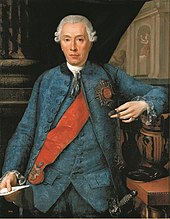Ludwig zu Salm-Salm
Ludwig Karl Otto zu Salm-Salm ( French Louis Charles Otthon de Salm-Salm ; born August 22, 1721 at Hoogstraten Castle in Antwerp , † July 29, 1778 in Senones ) was the first-born son of the wealthy Nikolaus Leopold, first prince of Salm- Salm , Duke of Hoogstraeten , Wild- and Rheingraf (1701–1770) and a member of the extensive Salm noble family .
Life
His parents Nikolaus Leopold zu Salm-Salm and Dorothea Franziska Agnes nee von Salm (1702–1751) fathered a total of 18 children. According to the principle of succession of the primogeniture , it was clear that Ludwig Karl Otto received the inheritance and that all other siblings were excluded. When he entered the clergy, his father and the family saw the dynastic succession threatened. In fact, there was now a possibility that the inheritance might go to the Church. Therefore, in his will, the father deviated from the house rules , in which the primogeniture was laid down, in order to ensure the continuation of the family. Son Maximilian Friedrich Ernst strove for a Fideikommiss , which assigned him the rights as the next-born son. With the death of the father, the legal complaints before the Imperial Court in Vienna began to interpret the will. Some of the numerous siblings took changing positions in this dispute, which led to the temporary invasion of the royal seat of Senones. The dispute was settled out of court through the so-called Paris Brotherly Peace of July 3, 1771. Maximilian Friedrich Ernst zu Salm-Salm inherited the title, rights and income of the Duke of Hoogstraeten. Only two years after this comparison, Maximilian Friedrich Ernst died in 1773.
Ludwig Karl Otto resigned from the clergy before the inheritance and, at the age of 54, three years before his death, married the 28-year-old Marie Anne Felicité Countess of Horion on May 30, 1775 (* May 12, 1743; † 9. May 1800), a daughter of the Chancellor of the Prince-Bishop of Liège . His time as reigning second prince of the Principality of Salm-Salm in the Vosges lasted only eight years. Even with the Senones Castle commissioned by him, the exterior facade was not finally completed. Five years after the death of his younger brother Maximilian, he died on July 29, 1778 without a direct male heir.
Konstantin , the son of the younger brother Maximilian Friedrich Ernst, as Duke of Hoogstraeten now became heir and thus the third Prince of Salm-Salm. The French Revolution ended the short-term existence of the Principality of Salm-Salm after just two years. Emperor Napoleon also ended his rule over Anholt and Hoogstraeten Castle in 1810 . Even the Congress of Vienna no longer established the independence of the annexed areas. The princes of Salm-Salm and Salm-Kyrburg remained from then on only wealthy rulers of the Kingdom of Prussia . The lordly legacy of Prince Nikolaus Leopold zu Salm-Salm, Duke of Hoogstraeten, Wild- and Rheingraf had perished 40 years after his death.
Like his father Nikolaus Leopold, his son Ludwig Karl Otto also recognized the value of legal titles. Among other things, he became heir and master of the castle in Loon op Zand near Tilburg ( North Brabant province , Netherlands ). Ludwig Karl Otto also bought the noble feudal estate Peenekamp in Anholt in 1774 and immediately transferred the property to his brother Karl-Alexander (1735–1796). This Renaissance- style mansion with 20 hectares of wooded area remained in the family until 1988.
literature
- Emanuel Prinz zu Salm-Salm : The emergence of the princely Salm-Salm'schen Fideikommiss with special consideration of the trials led before the highest imperial courts up to the Paris brotherly peace of July 2nd, 1771. ISBN 3-8258-2605-8 .
| personal data | |
|---|---|
| SURNAME | Ludwig zu Salm-Salm |
| ALTERNATIVE NAMES | Ludwig Karl Otto Prince of Salm-Salm (full name) |
| BRIEF DESCRIPTION | 2. Prince in the Principality of Salm-Salm (1770–1778) |
| DATE OF BIRTH | August 22, 1721 |
| PLACE OF BIRTH | Hoogstraten Castle, Antwerp |
| DATE OF DEATH | July 29, 1778 |
| Place of death | Senones |

